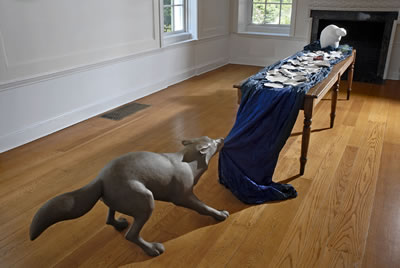
|
Lorna Mills and Sally McKay
Digital Media Tree this blog's archive OVVLvverk Lorna Mills: Artworks / Persona Volare / contact Sally McKay: GIFS / cv and contact |
View current page
...more recent posts

David's The Oath of the Horatii is in Toronto right now and so is the sketch treatment of the painting by Ingres. They are part of the AGO show Drama and Desire: Artists and the Theatre, "featuring artwork inspired by the theatre, presented 'on stage' with live performers, full-scale sets and period lighting." It's a fantastic summer show. There's a bunch of hilarious Neo-Classical paintings, over-the-top romantic paintings and etchings of scenes from Shakespeare, there's work by Ingres, Delacroix, Degas, Aubrey Beardsley...tons and tons of really canonical drawings and paintings from the history books. The whole thing is staged in a fabulously cheesy theatrical setting with velvet drapery, proscenia and chandeliers, interactive props, and actors in costume wandering around spouting sonnets. When I'd just read the promo I didn't really get the concept. Well, actually I was expecting something sort of exactly like what it is, only bad. But the art is really worth looking at, with or without the theatrical theme, so there's no sense that the curators are trying to force an idea. Instead, the theatrical context is just a really fun environment for spending time with a bunch of great art and enjoying all the cheese factor that's also in the work.



blingee by L.M.
The limitations of the Computational Theory of Mind might seem kind of obvious ó while the syntactical structure of language may be formally discrete, context, memory and shifting paradigms are inherently necessary to the construction of meaning. A computer may be programmed with an extensive vocabulary of terms, but the meanings of each unit would have to be computed against a background environment of infinitely variable conditions. This framing problem has proven to be a serious set-back. As computational cognitive scientist Jerry Fodor points out...
The failure of AI is, in effect, the failure of the Classical Computational Theory of the Mind to perform well in practice. Failures of a theory to perform well in practice are much like failures to predict the right experimental outcomes (arguably, indeed, the latter is a special case of the former). For well-known Duhemian reasons, neither shows straight off that the theory in question is false. But neither, on the other hand, do they bode the theory in question an awful lot of good. If having such failures doesnít keep you awake at night, youíre a lot more sanguine about your theories than I am about mine.Computational Theory is to neuroscience what String Theory is to theoretical physics ó a compelling idea that has lost significant scientific credibility due to its failure, over time, to produce empirical results.
Jerry Fodor, The Mind Doesn't Work That Way: The Scope and Limits of Computational Psychology, 2001. pg. 38

Sunday - Habanera

Maria Callas 1962 Covent Garden
Beaker (courtesy of Beth Stuart)






Carmen Amaya - Zambra








R.M. Vaughan reviews Mary Ann Barkhouseís The Reins of Chaos at the Latcham Gallery in Stouffville, Ont. He closes with this paragraph:
"A side note: The Reins of Chaos is related to a series of Barkhouse installations that situate animal sculptures in disjointed, otherworldly domestic settings. Her last touring exhibition, Boreal Baroque, tucked rabbits, owls and other woodland creatures into tidy, chintz-draped parlours. One canít help wondering why or how these powerful and charming works were overlooked by Adaptation: Between Species, the Power Plantís new, and very large, humans-meet-animals show. Surely one Barkhouse work is worth any two European videos?"
That of course, begs the question, how did the Power Plant's out-going curator, Helena Reckitt, manage to exclude so many First Nation's artists from Adaptation: Between Species currently on at the Power Plant?

Mary Ann Barkhouse harvest 2009 Bronze, wood, porcelain, taffeta

Mary Ann Barkhouse Boreal Baroque 2009